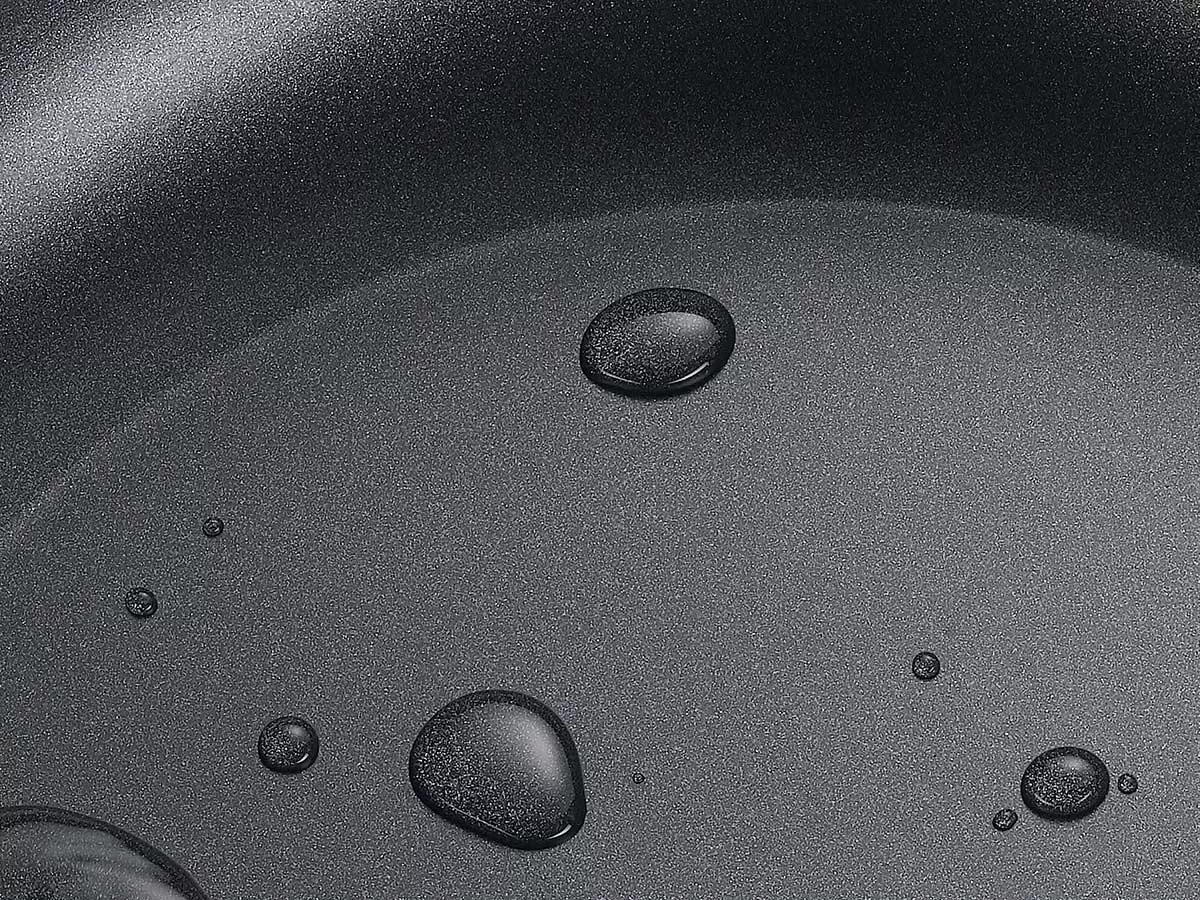Understanding Mica Coating: Advanced Non-Stick Technology
Definition and Properties of Mica
Mica coating is a specialized non-stick technology that utilizes mica minerals to create a smooth surface on cookware. This coating is known for its excellent heat resistance and durability. Mica can withstand continuous temperatures up to 1,292°F (700°C), making it ideal for various cooking methods. Key properties include:
- Non-stick surface: Prevents food from sticking, making cooking and cleaning easier.
- Thermal stability: Maintains performance under high heat.
- Chemical resistance: Resists damage from acidic or alkaline foods.
Historical Development of Mica Coatings
Mica has been used for centuries in various applications, but its use in cookware is relatively recent. The development of mica coatings began in the late 20th century, focusing on enhancing cooking performance and safety. Over time, manufacturers have improved the formulation to ensure better adhesion and durability.
Comparison with Other Non-Stick Technologies
When comparing mica coatings to other non-stick technologies, such as PTFE (Teflon) and ceramic coatings, several factors come into play:
| Feature | Mica Coating | PTFE Coating | Ceramic Coating |
|---|---|---|---|
| Heat Resistance | Up to 1,292°F (700°C) | Up to 500°F (260°C) | Up to 1,200°F (650°C) |
| Durability | High | Moderate | High |
| Environmental Impact | Low | Moderate | Low |
Mica coatings offer a unique blend of durability and heat resistance, making them a strong contender in the non-stick market. Unlike PTFE, which can degrade over time, mica maintains its properties longer, providing a reliable cooking surface.
Mica coatings represent a significant advancement in non-stick technology, combining durability with high-temperature performance. Their unique properties make them suitable for both home and industrial cookware.
Applications of Mica Coating in Cookware
Benefits for Home Cooking
Mica coating offers several benefits for home cooking. Here are some key points:
- Non-Stick Surface: Mica-coated cookware provides a smooth, non-stick surface that makes cooking and cleaning easier.
- Heat Resistance: It can withstand high temperatures, making it suitable for various cooking methods.
- Durability: Mica coatings are known for their long-lasting properties, reducing the need for frequent replacements.
Industrial Uses in Food Preparation
In industrial settings, mica coating is utilized for its unique properties:
- Food Safety: Mica coatings are safe for food contact, ensuring that meals are prepared without harmful chemicals.
- Efficiency: The non-stick nature allows for quicker cooking times and easier cleanup, enhancing productivity in commercial kitchens.
- Versatility: Mica-coated cookware can be used in ovens, stovetops, and even grills, making it adaptable for various cooking environments.
Case Studies of Mica-Coated Cookware
Several brands have successfully integrated mica coatings into their products. Here are a few examples:
- Brand A: Known for its lightweight, mica-coated frying pans that offer excellent heat distribution.
- Brand B: Specializes in mica-coated bakeware that ensures even baking and easy release of baked goods.
- Brand C: Focuses on eco-friendly mica coatings that are safe for both the environment and consumers.
Mica-coated cookware not only enhances cooking performance but also promotes healthier meal preparation by reducing the need for excess oils and fats.
The Science Behind Mica Coating
Chemical Composition and Structure
Mica is a naturally occurring mineral composed mainly of silicate. Its unique layered structure allows it to be flexible and heat-resistant. This makes mica an excellent choice for non-stick coatings. The layers can be easily separated, which contributes to its non-stick properties.
Manufacturing Process
The production of mica coatings involves several steps:
- Mining: Mica is extracted from the earth.
- Processing: The mica is ground into fine particles.
- Coating Application: The processed mica is applied to cookware surfaces using advanced techniques.
Performance Metrics and Testing
Mica coatings are tested for various performance metrics, including:
- Non-stick capability: How well food releases from the surface.
- Durability: Resistance to scratches and wear.
- Heat resistance: Ability to withstand high cooking temperatures.
| Metric | Mica Coating | PTFE Coating | Ceramic Coating |
|---|---|---|---|
| Non-stick Capability | High | Moderate | Low |
| Durability | High | Low | Moderate |
| Heat Resistance | High | Moderate | High |
Mica coatings are becoming increasingly popular due to their enhanced durability and thermal stability. As technology advances, we can expect to see more emerging applications for mica in various industries, including cookware and beyond.
Advantages of Mica Coating Over Traditional Non-Stick Coatings
Enhanced Durability and Abrasion Resistance
Mica coatings are known for their superior durability compared to traditional non-stick options. They resist scratches and wear better, making them ideal for everyday cooking. Here are some key points:
- Mica coatings can withstand higher temperatures without degrading.
- They are less prone to chipping and peeling.
- Their surface remains smooth, ensuring easy food release.
Thermal Stability and Heat Resistance
Mica coatings excel in thermal stability, allowing them to perform well under high heat. This is crucial for cooking methods that require intense heat. Some benefits include:
- High heat tolerance without losing non-stick properties.
- Ability to maintain structural integrity at elevated temperatures.
- Reduced risk of releasing harmful chemicals when heated.
Environmental and Health Benefits
Mica coatings are often considered more environmentally friendly than traditional non-stick coatings. They do not contain harmful chemicals like PTFE, which can break down at high temperatures. Here are some advantages:
- Mica is a natural mineral, making it a safer choice for cookware.
- No toxic fumes are released during cooking.
- Mica coatings are often recyclable, contributing to sustainability.
Mica coatings represent a significant advancement in non-stick technology, offering a blend of durability, safety, and performance that traditional coatings often lack.
| Feature | Mica Coating | Traditional Non-Stick Coating |
|---|---|---|
| Durability | High | Moderate |
| Heat Resistance | Excellent | Good |
| Environmental Impact | Low | Moderate to High |
Challenges and Limitations of Mica Coating
Potential Drawbacks in Everyday Use
Mica coatings, while beneficial, come with some challenges that users should consider:
- Cost: Mica coatings can be more expensive than traditional non-stick options.
- Weight: Mica-coated cookware may be heavier, making it less convenient for some users.
- Maintenance: Special care is needed to maintain the coating's effectiveness.
Cost and Production Issues
The production of mica coatings involves several steps that can lead to increased costs:
- Raw Material Sourcing: Extracting mica can be costly and environmentally challenging.
- Processing: The manufacturing process requires advanced technology, which can drive up prices.
- Market Demand: As demand increases, prices may rise further, affecting affordability.
Future Research Directions
To address these challenges, ongoing research is essential. Some areas of focus include:
- Improving Durability: Developing stronger coatings that last longer.
- Cost Reduction: Finding ways to lower production costs without sacrificing quality.
- Sustainability: Exploring eco-friendly extraction methods to minimize environmental impact.
Mica coatings offer unique benefits, but understanding their limitations is crucial for informed choices in cookware.
| Challenge | Description |
|---|---|
| Cost | Higher than traditional non-stick coatings |
| Weight | Can be heavier, affecting usability |
| Maintenance | Requires special care to maintain effectiveness |
Innovations and Future Prospects in Mica Coating Technology
Recent Advances in Mica Coating
Mica coating technology is evolving rapidly, with new techniques enhancing its effectiveness. Recent innovations include:
- Textured surfaces that improve non-stick properties.
- Eco-friendly options that reduce environmental impact.
- Smart coatings that respond to temperature changes.
Emerging Applications Beyond Cookware
Mica coatings are not just for cookware anymore. They are finding uses in various fields, such as:
- Fire protection in industrial settings.
- Electrical insulation in electronics.
- Biomedical applications for drug delivery systems.
Predictions for Market Growth
The mica market is projected to grow significantly, reaching USD 2,720.47 million by 2031. This growth is driven by:
- Increased demand for sustainable materials.
- Technological advancements in mica processing that improve efficiency and reduce environmental impact.
- A shift towards customized non-stick coatings for specific cooking needs.
Mica's versatility and adaptability make it a key player in future innovations, promising exciting developments across various industries.
Comparative Analysis of Mica Coating with PTFE and Ceramic Coatings
Performance in Non-Stick Capabilities
Mica coatings, PTFE, and ceramic coatings each have unique non-stick properties. Mica coatings excel in providing a smooth surface that resists sticking, while PTFE is known for its excellent non-stick capabilities. However, ceramic coatings often struggle to match these performance levels. Here’s a quick comparison:
| Coating Type | Non-Stick Performance | Durability | Heat Resistance |
|---|---|---|---|
| Mica | High | Moderate | Excellent |
| PTFE | Very High | Low | Moderate |
| Ceramic | Moderate | High | High |
Durability and Lifespan
- Mica coatings are generally more durable than PTFE but less so than ceramics.
- PTFE coatings can wear out quickly, especially with high heat and abrasive use.
- Ceramic coatings tend to last longer but may not perform as well in non-stick tests.
Consumer Preferences and Feedback
- Many consumers prefer mica coatings for their balance of performance and safety.
- PTFE is often chosen for its superior non-stick properties, despite concerns about durability.
- Ceramic coatings are favored for their eco-friendliness and heat resistance, even if they require more care.
Mica coatings represent a promising alternative to traditional non-stick options, combining safety and performance in a way that appeals to modern consumers.
In summary, while each coating has its strengths and weaknesses, mica coatings stand out for their unique properties that cater to both safety and functionality in cookware.
Conclusion
In summary, mica coating represents a significant advancement in non-stick technology. This innovative coating not only makes cooking easier by preventing food from sticking but also enhances the durability of cookware. Unlike traditional coatings, mica offers better resistance to scratches and wear, ensuring that your pots and pans last longer. As we continue to explore new materials and methods, mica's unique properties could lead to even more exciting developments in kitchenware. Embracing this technology means enjoying a more efficient cooking experience while also caring for our environment.









